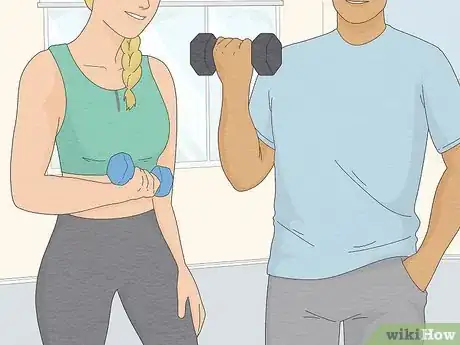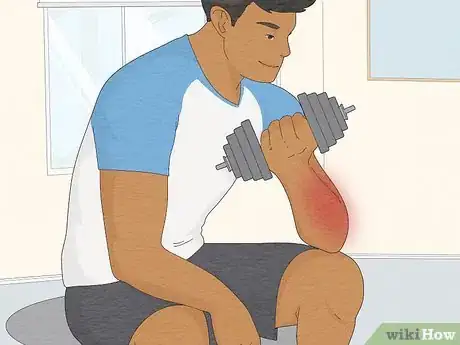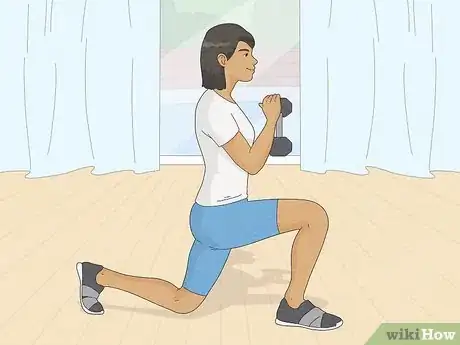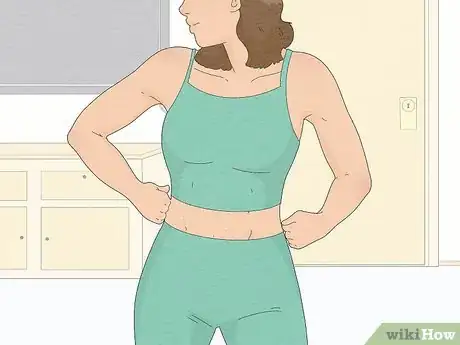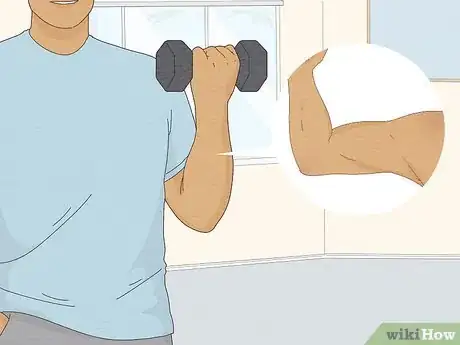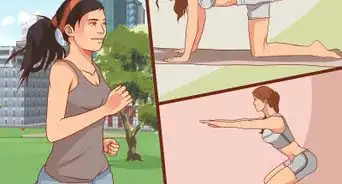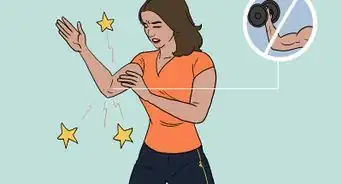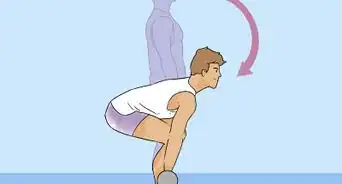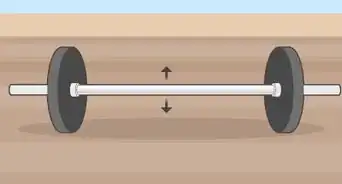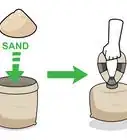This article was co-authored by Julian Arana, M.S.eD., NCSF-CPT and by wikiHow staff writer, Eric McClure. Julian Arana is a Personal Trainer and the Founder of B-Fit Training Studios, a personal training and wellness set of studios based in Miami, Florida. Julian has over 12 years of personal training and coaching experience. He is a certified personal trainer (CPT) by the National Council on Strength and Fitness (NCSF). He has a BS in Exercise Physiology from Florida International University and an MS in Exercise Physiology specializing in strength and conditioning from the University of Miami.
There are 16 references cited in this article, which can be found at the bottom of the page.
This article has been viewed 594,246 times.
If you’re looking for big muscles, dumbbell workouts are a phenomenal way to go. While most people picture someone doing bicep exercises with dumbbells, you can actually incorporate dumbbells into a variety of exercises to get a full-body workout. Even if you just hold them while you do squats or lunges, you’re going to see massive gains over time from the addition of some weight resistance. Keep in mind that it takes time bulk up, so don’t get discouraged if you feel like you aren’t getting bigger after a few weeks of lifting!
Steps
How do I bulk my arms up with dumbbells?
-
1Do bicep curls to build bicep muscles. Stand with a straight back and hold both dumbbells in your hands. To do a standard curl, raise the dumbbell in each arm slowly up to your shoulder. Focus on keeping your entire body still while your arms are moving. Once you’ve raised each dumbbell up and lowered it to the original position, count 1 rep.[6]
-
2Do lateral raises to build your shoulder muscles. Stand up straight and let the dumbbells hang at your sides. Then, flex your core and slowly raise the weights out to your side. Hold the weights at shoulder level and slowly lower them down to count 1 rep. Keep your back and legs as straight as possible.[7]
-
3Use overhead extensions to bulk your triceps up. Sit down in a chair and hold one dumbbell behind your head with both hands. Keep your elbows bent at a 90-degree angle. Breathe in as you slowly lower the weight a few inches behind you. Then, breathe out as you lift the dumbbell straight up and extend your elbows to count 1 rep.[8]
How do I work out my chest and back with dumbbells?
-
1For your back, do dumbbell rows to get big muscles. Grab just one dumbbell and lean over the side of a bench or coffee table so your back is parallel to the ground. Let the dumbbell hang down in your hand. Slowly raise it directly straight up until it’s at the same height as your side. Slowly lower the weight back down to count 1 rep. Switch arms when you’re done with the first arm.[9]
-
2Do the bench press with dumbbells to build your chest up. Lay down on a lifting bench with a dumbbell in each hand. Hold the weights over your chest and slowly raise them up above you at the same time. Keep your movements contained and don’t arch your back off of the ground. Lower the weights slowly back to your chest to count 1 rep.[10]
How do I build lower body muscle with dumbbells?
-
1Do reverse lunges with dumbbells to bulk up. Grab your dumbbells and step back with your right foot. Lower your hips and lean forward to lower the dumbbells near the ground. Then, push your left foot down and swing your right foot forward to return to a standing position. Alternate side and repeat the process by putting your left foot back to count 1 rep.[11]
-
2Hold dumbbells while doing squats to work your legs. Grab your dumbbells and hold them next to your hips. Keep your knees bent and your back straight. Slowly you’re your hips down and back to lower yourself into a squat position. Stop once your thighs are parallel to the ground and extend back up to the standing position to count 1 rep.[12]
Expert Q&A
-
QuestionIs it possible to build muscle with just dumbbells?
 Julian Arana, M.S.eD., NCSF-CPTJulian Arana is a Personal Trainer and the Founder of B-Fit Training Studios, a personal training and wellness set of studios based in Miami, Florida. Julian has over 12 years of personal training and coaching experience. He is a certified personal trainer (CPT) by the National Council on Strength and Fitness (NCSF). He has a BS in Exercise Physiology from Florida International University and an MS in Exercise Physiology specializing in strength and conditioning from the University of Miami.
Julian Arana, M.S.eD., NCSF-CPTJulian Arana is a Personal Trainer and the Founder of B-Fit Training Studios, a personal training and wellness set of studios based in Miami, Florida. Julian has over 12 years of personal training and coaching experience. He is a certified personal trainer (CPT) by the National Council on Strength and Fitness (NCSF). He has a BS in Exercise Physiology from Florida International University and an MS in Exercise Physiology specializing in strength and conditioning from the University of Miami.
Certified Personal Trainer Yes, but be patient. You aren’t going to see any gains just by lifting for 1-2 weeks and then calling it quits. Change takes time, so stick with it once you start!
Yes, but be patient. You aren’t going to see any gains just by lifting for 1-2 weeks and then calling it quits. Change takes time, so stick with it once you start! -
QuestionHow can you get strong with very little equipment?
 wikiHow Staff EditorThis answer was written by one of our trained team of researchers who validated it for accuracy and comprehensiveness.
wikiHow Staff EditorThis answer was written by one of our trained team of researchers who validated it for accuracy and comprehensiveness.
Staff Answer wikiHow Staff EditorStaff AnswerIf your goal is just to improve your strength, you technically don't need any equipment at all. Pushups, pullups, crunches, and burpees are all great callisthenic exercises that will make you stronger. If you do want to weight train, look into getting adjustable dumbbells. That way, you can adjust the weight to modify your workouts as needed, and you'll only need the one set of weights.
wikiHow Staff EditorStaff AnswerIf your goal is just to improve your strength, you technically don't need any equipment at all. Pushups, pullups, crunches, and burpees are all great callisthenic exercises that will make you stronger. If you do want to weight train, look into getting adjustable dumbbells. That way, you can adjust the weight to modify your workouts as needed, and you'll only need the one set of weights. -
QuestionHow much weight should I start with?
 wikiHow Staff EditorThis answer was written by one of our trained team of researchers who validated it for accuracy and comprehensiveness.
wikiHow Staff EditorThis answer was written by one of our trained team of researchers who validated it for accuracy and comprehensiveness.
Staff Answer wikiHow Staff EditorStaff AnswerThe goal is to feel some burn towards the end of your set without being totally exhausted. If you're brand new to weightlifting, grab a light set (5-20 pounds depending on what feels comfortable) and try to do 22 bicep curls. If you get all the way to 22 without breaking a sweat, add weight. If you can't even get to 14 reps without your arms giving out, remove 5 pounds and try again. Once you find a weight where you feel a burn but you aren't compromising your form by the 22nd rep, that's your starting weight.
wikiHow Staff EditorStaff AnswerThe goal is to feel some burn towards the end of your set without being totally exhausted. If you're brand new to weightlifting, grab a light set (5-20 pounds depending on what feels comfortable) and try to do 22 bicep curls. If you get all the way to 22 without breaking a sweat, add weight. If you can't even get to 14 reps without your arms giving out, remove 5 pounds and try again. Once you find a weight where you feel a burn but you aren't compromising your form by the 22nd rep, that's your starting weight.
Warnings
- If you have any kind of underlying health condition, talk to your doctor before you start an exercise routine just to make sure it’s safe.[22]⧼thumbs_response⧽
References
- ↑ https://www.self.com/story/weight-lifting-increase
- ↑ https://www.issaonline.com/blog/index.cfm/2016/ladies-lifting-heavy-wont-make-you-bulk-up
- ↑ https://dailyburn.com/life/fitness/how-to-build-muscle-fast-pick-weights/
- ↑ https://pubmed.ncbi.nlm.nih.gov/17530977/
- ↑ https://www.issaonline.com/blog/index.cfm/2016/ladies-lifting-heavy-wont-make-you-bulk-up
- ↑ Julian Arana, M.S.eD., NCSF-CPT. Certified Personal Trainer. Expert Interview. 19 March 2020.
- ↑ https://www.coachmag.co.uk/shoulder-workouts/4248/the-dumbbell-shoulder-workout-to-build-cannonball-shoulders
- ↑ https://www.gqindia.com/look-good/content/5-best-dumbbell-only-triceps-workouts-to-build-bulky-arms-fitness-exercises
- ↑ Julian Arana, M.S.eD., NCSF-CPT. Certified Personal Trainer. Expert Interview. 19 March 2020.
- ↑ https://www.coachmag.co.uk/chest-exercises/7391/how-to-do-the-dumbbell-bench-press
- ↑ https://www.acefitness.org/education-and-resources/professional/expert-articles/5675/5-benefits-of-dumbbell-training/
- ↑ https://www.stack.com/a/dumbbell-squat
- ↑ https://www.vice.com/en/article/evww9j/how-fast-can-you-expect-to-build-muscle-naturally
- ↑ https://www.acefitness.org/education-and-resources/professional/expert-articles/5675/5-benefits-of-dumbbell-training/
- ↑ https://www.partnermd.com/blog/is-a-30-minute-workout-really-enough
- ↑ Julian Arana, M.S.eD., NCSF-CPT. Certified Personal Trainer. Expert Interview. 19 March 2020.
- ↑ Julian Arana, M.S.eD., NCSF-CPT. Certified Personal Trainer. Expert Interview. 19 March 2020.
- ↑ https://www.theactivetimes.com/why-rest-days-are-just-important-working-out
- ↑ https://www.mayoclinic.org/healthy-lifestyle/fitness/in-depth/exercise/art-20047414
- ↑ https://www.acs.org/content/acs/en/education/resources/highschool/chemmatters/past-issues/2017-2018/april2018/the-protein-myth.html
- ↑ https://www.ncbi.nlm.nih.gov/pmc/articles/PMC6680710/
- ↑ https://www.mayoclinic.org/healthy-lifestyle/fitness/in-depth/exercise/art-20047414

